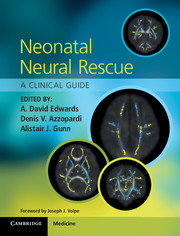Book contents
- Frontmatter
- Contents
- List of contributors
- Foreword
- Section 1 Scientific background
- Section 2 Clinical neural rescue
- Section 3 The future
- 18 Novel neuroprotective therapies
- 19 Combining hypothermia with other therapies for neonatal neuroprotection
- 20 Biomarkers for studies of neuroprotection in infants with hypoxic–ischaemic encephalopathy
- Index
- References
19 - Combining hypothermia with other therapies for neonatal neuroprotection
from Section 3 - The future
Published online by Cambridge University Press: 05 March 2013
- Frontmatter
- Contents
- List of contributors
- Foreword
- Section 1 Scientific background
- Section 2 Clinical neural rescue
- Section 3 The future
- 18 Novel neuroprotective therapies
- 19 Combining hypothermia with other therapies for neonatal neuroprotection
- 20 Biomarkers for studies of neuroprotection in infants with hypoxic–ischaemic encephalopathy
- Index
- References
Summary
Introduction
There is compelling evidence that therapeutic hypothermia confers significant benefit in term neonates with post-asphyxial encephalopathy. Yet, over 40% of treated infants have poor neurodevelopmental outcomes and there is an urgent need to identify treatments that effectively supplement the beneficial effects of hypothermia. This chapter focuses on discussion of clinically available therapeutic agents that could be administered in conjunction with hypothermia and that have the potential to augment the neuroprotective efficacy of cooling. Target populations for combination therapies include both infants who have poor outcomes with current treatments and also infants who are ultimately classified as having “good” outcomes, but who could have the potential for better long-term neurobehavioural function.
There is an inevitable delay period before therapeutic hypothermia can be started. Since time to onset of cooling is a major determinant of neuroprotective efficacy experimentally, agents that extended the duration of the therapeutic window for initiation of hypothermia would be desirable. Supplemental therapies could conceivably be administered prenatally, intra-partum, in conjunction with resuscitation, during post-resuscitation stabilization, or during transport to a neonatal intensive care unit. For any treatment administered more broadly to “at risk” neonates, before a diagnosis of encephalopathy, safety would be a critical pre-requisite and adequate documentation of safety in this population would inevitably be very challenging. For agents administered to symptomatic neonates, concurrently with onset of cooling, it would be essential to analyze drug/hypothermia interactions and take into account the impact of acute kidney or liver injury on drug pharmacokinetics. As more is understood both about endogenous mechanisms of brain repair and the mechanisms that underlie the beneficial effects of hypothermia, it may also become feasible to target therapies specifically to replicate or strengthen these mechanisms to enhance recovery after the end of hypothermia.
- Type
- Chapter
- Information
- Neonatal Neural RescueA Clinical Guide, pp. 208 - 218Publisher: Cambridge University PressPrint publication year: 2013



